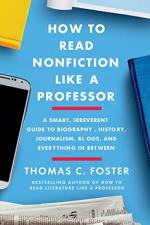
|
| Name: _________________________ | Period: ___________________ |
This quiz consists of 5 multiple choice and 5 short answer questions through Section 5: Chapter 16, "Social (Media) Disease" through "Conclusion".
Multiple Choice Questions
1. In Chapter 2, "The Ecology of the Nonfiction Biosphere," what problem does Foster say can arise if readers do not understand the forms of writing?
(a) Readers may expect the wrong things from the form they are reading.
(b) Readers may be disappointed by the content of their reading.
(c) Readers may have unreasonably high standards.
(d) Readers may misunderstand the purpose of the form they are reading.
2. Chapter 15, "Reading Internet Sources," ends with the date of singer Roy Orbison's birthday. What is Foster's purpose in placing this piece of information here?
(a) To create humor.
(b) To create suspense.
(c) To illustrate his point about trust.
(d) To offer support for his criticism of Wikipedia.
3. In Chapter 13, "On the Stump," Foster says that Omarosa "uses her first name mononymously" (188). What does this mean about her use of her first name?
(a) She uses it for professional work, but it is not her real first name.
(b) She uses it alone, as a one-word name, without her last name.
(c) She uses her last (family) name as her first (personal) name.
(d) She uses a nickname as her first name, but it is not her legal first name.
4. In Chapter 16, "Social (Media) Disease," Foster uses the expression "a funny thing happened on the way to the forum" (267-268). What device is he employing, here?
(a) Allusion.
(b) Symbolism.
(c) Sarcasm.
(d) Parallelism.
5. According to Chapter 17, "The Criminal Element," what fraud did Lee Israel commit?
(a) Forged hundreds of letters that were supposedly from famous authors.
(b) Wrote news articles based on fake evidence.
(c) Passed off a fictional work as her own autobiography.
(d) Wrote a fake autobiography of Howard Hughes.
Short Answer Questions
1. In Chapter 6, "Source Code," what consequence does Foster say the rise of the internet has had?
2. In Chapter 11, "Life from the Inside," Foster points out that Ta-Nehisi Coates's Between the World and Me begins similarly to which other work?
3. In Chapter 15, "Reading Internet Sources," what does Foster say a subreddit is?
4. In Chapter 2, "The Ecology of the Nonfiction Biosphere," what does Foster say is the difference between "hard news" and "soft news"?
5. In Chapter 5, "It May Just Be Me, But..." what does Foster say is true about quotes attributed to anonymous sources?
|
This section contains 526 words (approx. 2 pages at 300 words per page) |

|




